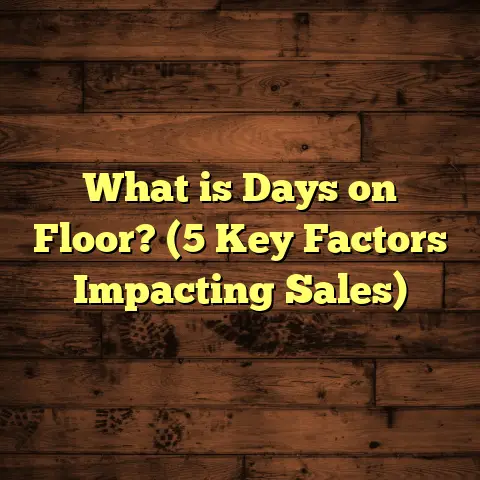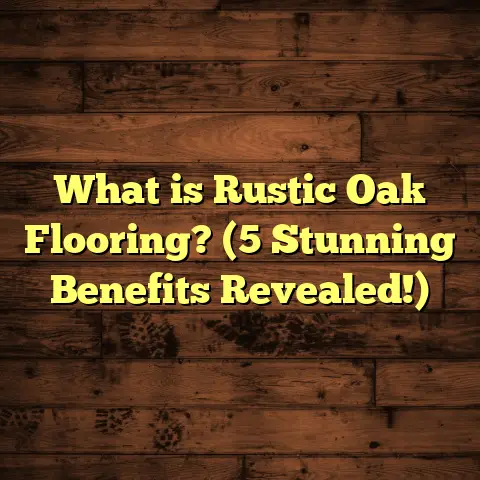What is Refinishing Hardwood Floors? (5 Steps to Stunning Results)
Did you realize that refinishing hardwood floors can not only restore their beauty but also add thousands of dollars to your home’s value? It’s a fact that surprises many homeowners. You might think hardwood floors are either perfect or hopelessly damaged. But in reality, most hardwood floors can be brought back to life with the right approach to refinishing.
I’ve been in the flooring business for over ten years, and I’ve seen some truly remarkable transformations. From scratched-up floors full of pet marks to decades-old wood that looked beyond repair — refinishing brought them back to stunning condition. It’s a process that combines skill, patience, and knowledge.
So, what exactly is refinishing hardwood floors? I want to take you on a journey through the entire process—from understanding what refinishing really means to the five crucial steps you need for fantastic results. Along the way, I’ll share stories from my own projects, data that backs up why refinishing makes sense, and tips that only experience can teach.
What Is Refinishing Hardwood Floors?
Refinishing hardwood floors means restoring the surface of your existing wood floor by sanding away the old finish and imperfections, then applying fresh stain and protective coatings. Instead of replacing your floors, you’re essentially giving them a brand-new lease on life.
Think about it: hardwood floors are made of solid wood planks or engineered layers designed to last decades when properly cared for. Over time, the finish wears down due to foot traffic, pets, spills, and sunlight exposure. Scratches appear, some stains settle in, and the wood can look dull or faded.
Refinishing removes the worn-out finish and smooths the wood surface through sanding. Then comes staining (optional) and sealing with finishes like polyurethane to protect and beautify the wood. The whole process allows you to customize color and sheen while preserving the original material beneath.
Why Does Refinishing Matter?
Hardwood flooring is an investment. According to data from Zillow and the National Association of Realtors, homes with hardwood floors sell for an average of 2-5% more than comparable homes without them. Refinishing keeps those floors looking their best so you maintain or even increase home value.
Refinishing extends floor life by 20 years or more — that’s what the National Wood Flooring Association (NWFA) reports. Instead of ripping out your floors when they look tired, you can rejuvenate them with refinishing.
Here’s a personal story: I once worked on a 1920s home with original hickory floors that were scratched to heck from decades of family life. The homeowners thought replacement was their only option. After refinishing, those floors looked almost new — rich in color and full of character. The family was thrilled to keep their historic home’s charm intact without spending thousands on new flooring.
If you’re wondering whether your floors qualify for refinishing or if it’s worth it, keep reading. I’ll break down how to assess your floors’ condition and guide you through each step of the process.
Step 1: Assessing Your Floor’s Condition — The Starting Point
You can’t fix what you don’t fully understand. Before any sanding or staining begins, examine your floors thoroughly. This step helps determine whether refinishing is feasible or if replacement might be necessary.
What To Look For?
- Scratches and Surface Damage: Are there light surface scratches or deeper gouges? Surface scratches are easily sanded out; deep gouges may require patching.
- Water Damage: Dark stains or warping from moisture can sometimes be sanded away if caught early but may need specialist repair.
- Finish Condition: Is the finish worn thin or peeling in spots? If so, refinishing is likely needed.
- Floor Thickness: How thick is your hardwood? Most solid wood floors allow 2-3 sandings before running out of material.
- Previous Repairs: Old repairs may affect sanding uniformity.
- Structural Issues: Check for loose boards or squeaks that might need fixing first.
How Thick Should Your Floor Be?
Thickness matters because sanding removes some wood with each pass. Typically:
- Solid hardwood is about 3/4 inch thick.
- Engineered hardwood has a thinner top wood layer (3mm-6mm).
If your hardwood is less than 3/8 inch thick, sanding may damage it beyond repair.
Testing Your Floors
If you’re unsure about thickness or condition, consider hiring a professional for an evaluation. I use moisture meters and depth gauges to precisely measure before recommending refinishing.
Real-Life Example
A client once called me worried their floors were ruined from a leaky dishwasher. After inspection, I found water stains but no structural damage. Sanding removed all discoloration and we refinished with a moisture-resistant finish for extra protection.
Data Point
According to Remodeling Magazine’s Cost vs. Value report 2024, refinishing hardwood floors returns approximately 70% of the project cost in resale value — a better return than carpet replacement or some kitchen upgrades.
Step 2: Preparing For Refinishing — Setting The Stage
Preparation might not sound exciting but it makes all the difference between a smooth project and frustrating setbacks.
Clearing The Room Completely
Remove every piece of furniture, rugs, curtains, and anything else that touches the floor. Even small objects like nails or debris can ruin sandpaper or create gouges during sanding.
Trust me—I’ve seen people forget chairs in corners or leave nails in place. That always creates costly delays.
Protecting Adjacent Areas
Sanding produces fine dust everywhere. Protect walls, doorways, vents, and other rooms by sealing off openings with plastic sheeting taped securely.
Wear a dust mask and use fans or ventilation if possible to reduce indoor airborne dust.
Gather All Necessary Tools And Materials
Here’s what you’ll need:
- Drum sander or orbital floor sander (rental recommended)
- Edge sander for corners
- Sandpaper discs/paper in multiple grits (usually 36, 60, 80, 100)
- Vacuum cleaner with HEPA filter
- Tack cloths for dust removal
- Floor stain (optional)
- Polyurethane or other finish
- Brushes, foam applicators, or lambswool pads for finish application
Renting Equipment
I highly recommend renting professional-grade sanders from local hardware stores or flooring suppliers instead of buying cheap models online. They’re more efficient, have better dust control attachments, and produce smoother results.
Personal Tip
When I started out refining floors myself without proper prep (and equipment), I wasted hours cleaning dust from hard-to-reach places and fixing uneven sanding spots.
Step 3: Sanding — The Most Critical Step
Sanding removes the old finish layer and smoothes out scratches and dents on the wood surface.
How Sanding Works
You start with coarse grit sandpaper (usually 36 grit) to strip off the existing finish entirely. Then progress through finer grits — medium grit (60-80) removes scratches left by coarse grit and preps the surface. Finally, a fine grit (100-120) smooths everything for finishing.
Skipping grit steps or rushing sanding can lead to uneven surfaces or visible scratches after finishing.
Sanding Machines: Drum vs Orbital
- Drum Sanders rotate a cylindrical drum covered with sandpaper at high speed. They’re aggressive and efficient but require skill to avoid gouging.
- Orbital Sanders move sandpaper in small circles; gentler but slower.
I usually recommend drum sanders for professionals or experienced DIYers since they produce flatter surfaces faster but caution beginners to practice first.
Edges & Corners
Big sanders can’t reach edges well, so an edge sander or hand sanding blocks are necessary here for consistent results.
Dust Control
Vacuum frequently between sanding passes to remove dust that can clog sandpaper and interfere with stain absorption later on.
My Experience With Sanding
Once I had a client who wanted DIY refinishing but rented a cheap sander that overheated and tore up their floor unevenly. I ended up re-sanding professionally afterward — which cost more than doing it right the first time!
Step 4: Staining — Adding Color And Depth
Staining is optional but lets you customize floor color from natural shades to rich hues like walnut or cherry tones.
Why Stain?
Stain enhances wood grain contrast and unifies color across varied planks. It also complements your room’s décor style.
How To Choose A Stain?
Test on an inconspicuous spot first because wood species absorb stain differently:
- Oak darkens beautifully.
- Maple tends to blotch without preconditioning.
- Pine may yellow under dark stains.
If you want even color on softer woods like pine or maple, use a wood conditioner before staining.
Application Tips
Apply stain evenly with brush or rag then wipe off excess quickly to prevent blotchy spots.
Let stain dry completely before applying finish—usually overnight.
Story From My Workbench
I had a client who preferred natural oak but wanted it darker without losing grain detail. We mixed two stain colors in small batches until we got just the right tone — something store-bought stains couldn’t match exactly.
Step 5: Applying Finish — Protecting Your Floors Long-Term
Finish seals and protects your floor against wear, moisture, dirt, and UV damage.
Types Of Finishes
- Oil-Based Polyurethane: Durable with amber tint; longer drying times; stronger smell.
- Water-Based Polyurethane: Clear finish; dries fast; low odor; popular choice today.
- Wax: Traditional; low durability; needs frequent reapplication.
- Penetrating Oil Finishes: Natural look; less protection; usually for specialty floors.
- Aluminum Oxide Coatings: Factory-applied on prefinished floors; extremely durable but not commonly applied onsite.
Water-based polyurethane is my go-to recommendation for most residential projects because it’s durable yet user-friendly with minimal odor.
Application Tips
Apply thin coats evenly using brushes or lambswool applicators. Sand lightly between coats with fine-grit sandpaper (220 grit) for smoothness.
Allow proper curing time—usually 24-48 hours before walking on floors and up to a week before heavy use.
My Finishing Mistakes Story
Early in my career, I once applied thick polyurethane layers without sanding between coats. This caused bubbling and uneven finish texture that took weeks to fix properly!
Overcoming Common Challenges In Refinishing Hardwood Floors
Every project has its curveballs. Here are some issues I’ve seen often:
Dust Control Problems
Dust can invade adjacent rooms and settle on wet finishes if not managed well. Using proper plastic barriers and vacuum systems helps keep this under control.
Uneven Sanding Marks
Rushing sanding steps leads to swirl marks or gouges. Slowing down and checking progress regularly prevents this.
Blotchy Stain Results
Soft woods tend to absorb stain unevenly without pre-treatment. Wood conditioners level absorption for consistent color.
Curing Time Impatience
Walking on wet finishes too soon can cause permanent marks and damage. It’s better to wait longer than rush use.
Cost Breakdown: How Much Does Refinishing Hardwood Floors Cost?
Here’s what typical costs look like:
| Item | Average Cost Range |
|---|---|
| Professional Labor | $2 – $4 per sq ft |
| Materials (Finish & Stain) | $0.50 – $1 per sq ft |
| Equipment Rental | $50 – $100 per day |
| DIY Project Total | $1 – $2 per sq ft |
| Professional Project Total | $3 – $5 per sq ft |
Labor accounts for most expenses since sanding and finishing require skill and time.
If you choose DIY, expect lower costs but factor in equipment rental and learning curve risks.
Case Study: Restoring A Century-Old Oak Floor
A couple bought a 100-year-old house with beautiful but worn oak floors stained dark brown in spots by water damage decades ago.
- After assessment, we confirmed solid wood thickness allowed multiple sanding passes.
- We removed old finish through sanding down to raw wood.
- Applied custom-mixed stain matching original tones but lighter overall.
- Finished with three coats of water-based polyurethane for durability.
The final result was stunning: warm oak tones with rich grain detail visible throughout entire space. The couple said it transformed their home’s ambiance completely — worth every penny invested.
Frequently Asked Questions About Refinishing Hardwood Floors
Q: How often can hardwood floors be refinished?
A: Usually 2-3 times depending on thickness—solid hardwood allows more than engineered wood.
Q: Can I refinish engineered hardwood floors?
A: Only if they have a thick enough top veneer (minimum ~3mm). Otherwise, sanding risks exposing plywood layers below.
Q: How long does refinishing take?
A: Professional jobs usually take 2-4 days depending on size and drying time between coats.
Q: Can I do it myself?
A: Yes! But prepare for learning curve; renting quality equipment is essential.
Final Thoughts On Refinishing Hardwood Floors
Refinishing hardwood floors is a rewarding process that brings back their natural beauty while extending their life span significantly. Whether you do it yourself or hire professionals like me, understanding each step—from assessing condition through sanding, staining, and finishing—ensures great results.
Remember: patience during sanding and finishing pays off with stunning floors that become a centerpiece of your home for years to come.
If you have hardwood floors showing wear or just want a change in color or shine, refinishing is worth considering before costly replacement options.
Feel free to ask me questions about your specific flooring situation—I’m happy to share advice from years working hands-on with all types of hardwood floors!
(End of article.)





